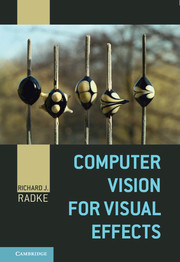Book contents
5 - Dense Correspondence and Its Applications
Published online by Cambridge University Press: 05 December 2012
Summary
In the last chapter we focused on detecting and matching distinctive features. Typically, features are sparsely distributed – that is, not every pixel location has a feature centered at it. However, for several visual effects applications, we require a dense correspondence between pixels in two images, even in relatively flat or featureless areas. One of the most common applications of dense correspondence in filmmaking is for slowing down or speeding up a shot after it's been filmed for dramatic effect. To create the appropriate intermediate frames, we need to estimate the trajectory of every pixel in the video sequence over the course of a shot, not just a few pixels near features.
More mathematically, we want to compute a vector field (u(x,y),v(x,y)) over the pixels of the first image I1, so that the vector at each pixel (x,y) points to a corresponding location in the second image I2. That is, the pixels I1(x,y) and I2(x +u(x,y),y + v(x,y)) correspond. We usually abbreviate the vector field as (u,v) with the understanding that both elements are functions of x and y.
Defining what constitutes a correspondence in this context can be tricky. As in feature matching, our intuition is that a correspondence implies that both pixels arise from the same point on the surface of some object in the physical world. The vector (u,v) is induced by the motion of the camera and/or the object in the interval between taking the two pictures.
- Type
- Chapter
- Information
- Computer Vision for Visual Effects , pp. 148 - 206Publisher: Cambridge University PressPrint publication year: 2012
- 1
- Cited by



